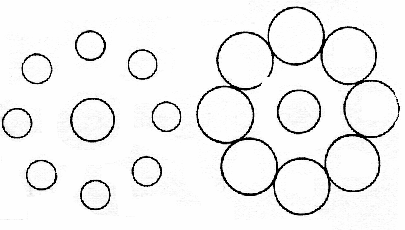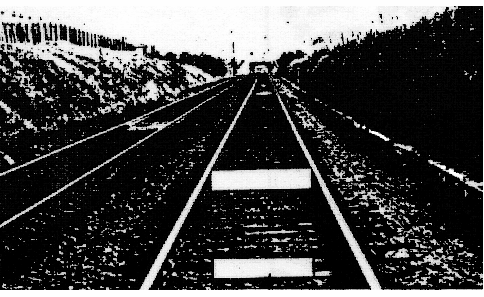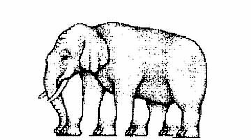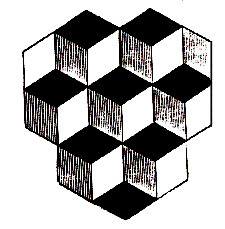When you are looking for fun things to do, spend time with the Illusions or play our Interactive games!
Below are two clusters of circles.Are the center circles in each cluster the same size? Is the left-center circle larger than the right-center circle or the right-center circle larger than the one?
 Click here for the answer
Click here for the answer
Answer : Same size.
The first ring of circles encasing the center-circle is drawn with small circles. They provide the illusion that there is a great amount of space around the center-circle than in the other drawing, thus making you think that the center-circle is larger than it is in reality. The circles in the second ring encasing the center-circle are much larger and even touch the edges. They create an illusion of being big and bold, thus making the center-circle appear crowded; or smaller than it really is. Take your finger or a ruler to measure the diameter of both circles to determine that they are of equal size.
Are the white rectangles found on the railroad tracks the same size? Is the one on top or bottom one larger?
 Click here for the answer
Click here for the answer
Answer : Same size
Here is an excellent example of one-point perspective. The railroad tracks are stretching off to infinity. Both of the rectangles are indeed the same size, as you will see if you were to measure the rectangles with a ruler. However, in reality, as something moves farther away, it will appear to recede in dimension. To prove this point, take an object and hold it in front of you. Facing a friend, if possible, ask him or her to stare at the object. Now slowly move backwards away from him or her. This person will notice that both you and the object that you are holding recede or get smaller in perspective with the greater distance from his or her vantage point. The reason for this illusion is that when you stand next to your friend, a lot of light hits you and bounces off of you and can reach the person. As you move farther and farther away from him or her, less light hits you and can bounce off of you, giving your friend the illusion that you, and the object you hold, are smaller.
How many legs does this elephant have? Four legs? Five legs?
 Click here for the answer
Click here for the answer
Answer : Four or five depending on viewing the top half or bottom half
Place a pinky finger across the mid section of the elephant. Count the number of legs seen. The answer will be five. Now place your pinky finger along the bottom edge across the elephant’s feet. Looking above the finger, count the number of legs. The answer will be four. To explain this illusion, focus on the trunk and the first leg. The illusionist used the back edge of the trunk and the front edge of the first leg to create an illusionary leg. The artist repeated this process with the next two legs; joining the back of one leg with the front of the next leg to create an illusion of an extra leg.
Which horizontal line is longer? The top one, the bottom one, or are both the same size?
 Click here for the answer
Click here for the answer
Answer : Same size.
This illusion is meant to trick you into thinking that the top line is larger. The brackets (with the greater and lesser symbols) are drawn to close in the line on one hand and to elongate the line on the other hand. Also, the illusionist who drew these lines did not line up the center lines. Instead the artist flushes the edges on the left hand side to accentuate how short the second line could be. In reality, they are of equal length. People have used a ruler to measure the center lines to prove that they are of the same length.
What do you see in the white intersections below? Gray dots, black dots, or no dots?
 Click here for the answer
Click here for the answer
Answer : Gray dots, which don’t exist.
In this sample, focus on the white lines separating the black squares, creating horizontal and vertical “rows.” When the black edges of the rectangles are found on either side of the white rows, it accentuates the white, making them appear whiter than they really are. At the intersections, the black squares can only offer their corners, thus not making the white seem to “pop out” any more than it is in reality. Thus, the intersection appears grayer than the rows themselves.
Count the number of cubes below. Are there six or seven cubes?
 Click here for the answer
Click here for the answer
Answer : Either six or seven, depending viewing them right or upside down.
Most people will look at the cubes and decide that the black diamonds are the top portions of the cubes, thus giving them an answer of seven cubes. A very small percentage of people will decide that the black diamonds are the bottom portions of the cubes. In this case, the answer is six cubes. In order to see that the cubes can be seen either way, turn the paper upside down and back again. This will help you visualize that the cubes can be viewed in different ways.
Is this a picture of an old woman or a young girl?
 Click here for the answer
Click here for the answer
Answer : Old woman looking down or young woman looking away.
Most people will state that they see an old woman, who is looking down to the left, and who has a very large nose with a wart on it. People will see the young woman looking away. In this case, the old lady’s mouth becomes the young girl’s necklace. The old lady’s nose becomes the young woman’s chin as she looks away from the viewer. The old lady’s eye becomes the young woman’s ear. The old lady’s wart becomes the young lady’s nose. Both answers are acceptable, depending on your point of view. Now try to switch between the two images.
Do you see two faces or one face?
 Click here for the answer
Click here for the answer
Answer : One face or two depending on your perspective.
In this example, if you see one face, it is staring straight ahead, face on. You will see two eyebrows, two eyes, a nose, and lips. On the other hand, try to see two faces, both staring at each other in profile. In this case, each half of the original face becomes a profile.
Look at the garbage cans below. Do the size of the cans get larger, from front to back, get smaller, or are they all the same size?
 Click here for the answer
Click here for the answer
Answer : Same size.
As the lines appear to move back towards the perspective line, they merge together to form a point. In this picture, the window and wall cut off the lines, so the observer can only see the front ends of the merging lines. In reality, as an object moves back into space, it appears to get smaller. In this sample, the answer is that the farthest garbage can indeed appears to be larger, because in reality it should be getting smaller as it travels away from the front edge of the paper. As the top and bottom lines of the fence slope towards one another, so too, should the top and bottom portions of the garbage cans. However, if you were to measure the garbage cans with a ruler, you would see that they are the same size.
Are the horizontal lines parallel to one another or are do they slope to either side?
 Click here for the answer
Click here for the answer
Answer : The horizontal lines are parallel.
This is a wonderful illusionary example. Look at how the boxes are skewered in an irregular pattern, as you examine them in vertical rows. Most people will state that the horizontal rows are sloped, due to this irregularity. Hold the paper up to eye level, glancing at it sideways. You will be able to perceive that the lines are indeed parallel. This can also be confirmed with a ruler.
Are the curved objects below the same size? Is the top one or bottom one wider?
 Click here for the answer
Click here for the answer
Answer : Same size.
These curved objects appear as if the top one is larger than the lower one. This illusion is created by comparing the bottom, curved line of the top object to the top line of the bottom object. Measure the objects with a ruler to determine that they are identical.
Are the circles pulling inwards or pushing outwards? Does the square below have straight or curvy lines?
 Click here for the answer
Click here for the answer
Answer : Inwards or outwards. Straight.
Depending on your point of view, the circles can appear to be convex (like an eyeball) or concave (like the inside of a bowl). If shading were included, this would have helped the viewer determine the answer. If the center circles were darker than the outer circles, it would appear convex. If the outer circles were darker than the center circles, it would appear concave. The other reason this illusion works is due to the amount of light. The closer things are, the brighter and more intense they appear because light bounces off the object and reaches your eyes. The farther away an object or focal point, the vaguer it will appear due to the diminished amount of light that bounces off of it that can reach your eyes. Most people will state that the lines are not straight along the edges of thev square. This illusion is created by having curved lines intersect the square. Hold the paper up to eye level to determine that the lines are straight. This can also be confirmed with the ruler.